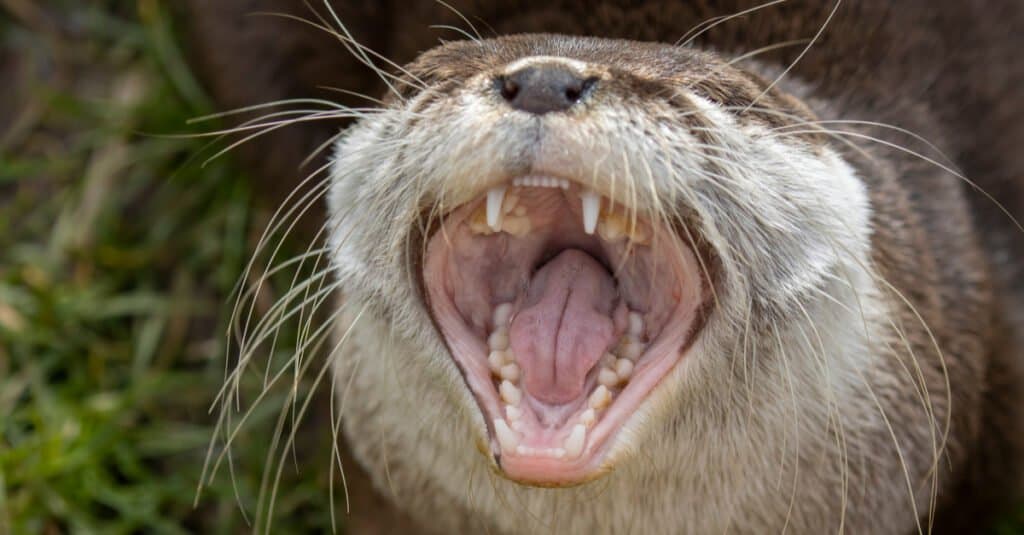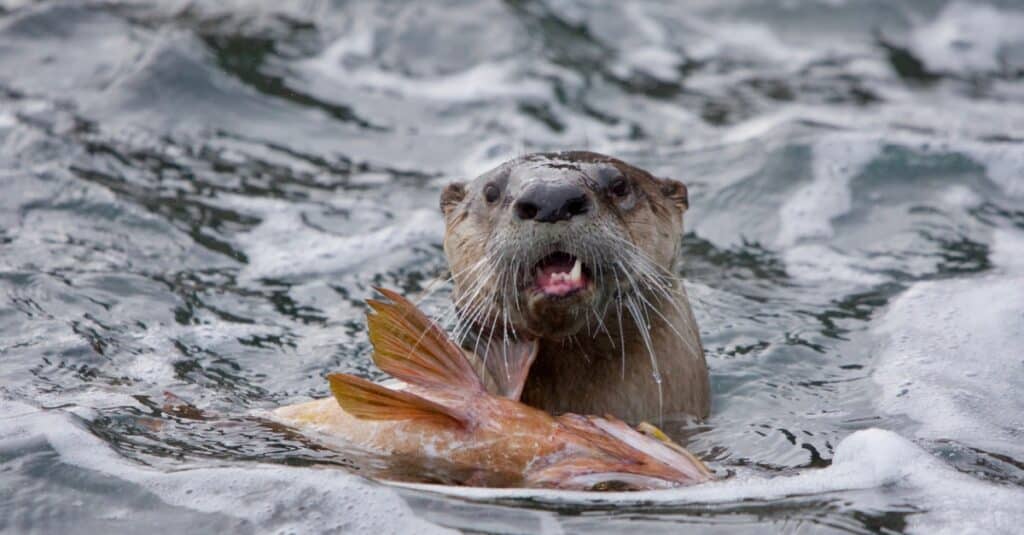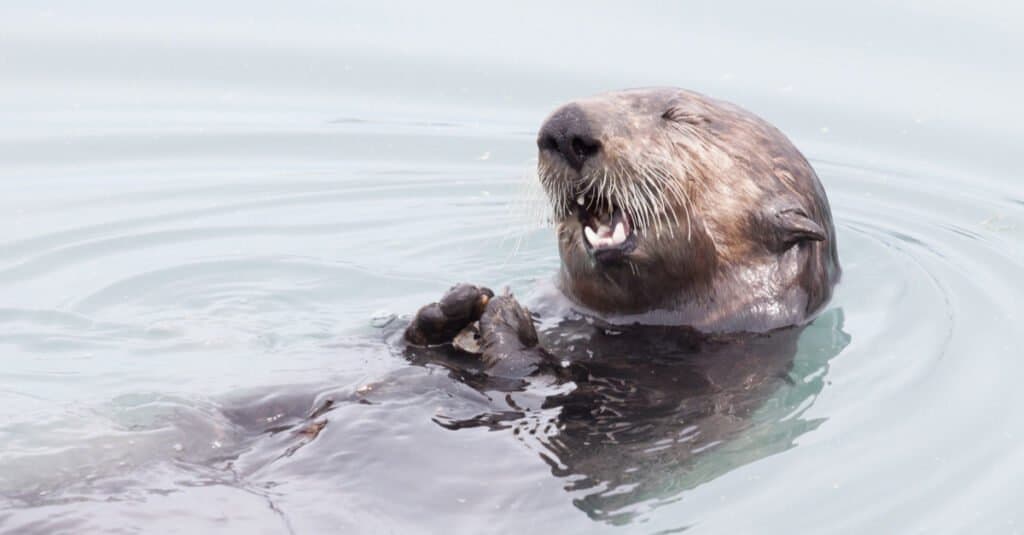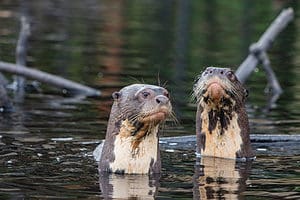Utterly charming, otters are web-footed weasels that inhabit rivers and seas around North America, Asia, Europe, Africa, and the Pacific. Otters are known to be intelligent and very social aquatic mammals. Their 13 species can settle in any body of water like rivers, lakes, streams, marshes, estuaries, and even at sea.
Otters are marine weasels that are equipped with webbed feet and strong tails to adapt to their marine environment. As mammals, otters can’t breathe underwater, but their noses and ears have openings that can close voluntarily to keep water out. Otters are also covered with thick fur and a furry undercoat made of about 900 million tiny hairs all over their bodies, making them one of the hairiest animals in the world. This fur also protects their bodies from the cold water temperature.
All otters are known to be adept hunters, whether they are in their freshwater habitats or at sea. They usually prey on crustaceans, fish, and reptiles. Below, we’ll explore everything you need to know about otter teeth, how they use them for hunting, and whether or not they bite.
What Kind of Teeth Do Otters Have?

Otters have powerful bites and large canines.
©Paul A Carpenter/Shutterstock.com
Otters’ teeth differ depending on what they eat. They who feed on fish, for instance, have sharp teeth that help them latch on their prey using their mouths, while otters who feed on crustaceans and other shellfish have more unsharpened teeth that are built for crushing instead of piercing through flesh.
River otters, for instance, eat a diet that consists mainly of fish. Because of their diet, they are equipped with teeth and jaws that are capable of catching and gripping onto slippery fish. River otters also have a powerful bite that helps them hold their prey tightly until they can bring them back to land.
Sea otters, on the other hand, feed mainly on crustaceans and shellfish. Because of this diet, they do not have as many incisors as river otters do. Most of a sea otter’s teeth are built for crushing shells of invertebrates instead of cutting, biting, and tearing animal meat.
How Many Teeth Do River Otters Have?

Adult river otters have 36 teeth.
©iStock.com/DanielLacy
River otters have a complete set of mammalian teeth: incisors, canines, premolars, and molars. Adult river otters typically have a total of 36 teeth, composed of 12 incisors, 4 canines, 14 premolars, and 6 molars. River otters normally have a dental formula of: incisors 3/3, canines 1/1, premolars 4/3, molars 1/2 = 36.
River otters have pointed canine teeth that may be a little smaller than other carnivorous mammals. However, they also possess serrated molars and premolars, collectively called “cheek teeth”, to help them crush their prey. The sharp teeth located at the front of their mouths, which are the incisors and canines, are built specifically to grasp and latch onto struggling prey long enough until they are brought back to land to be killed and eaten.
How Many Teeth Do Sea Otters Have?

Sea otters have 32 teeth.
©Dai Mar Tamarack/Shutterstock.com
Sea otters have fewer teeth compared to freshwater otters, as they do not need as many incisors to tear through their prey’s flesh. Adult sea otters have approximately 32 teeth because their incisors lack in number. Most of a sea otter’s teeth are post-canine molars to help them grind shellfish and crustaceans. The typical dental formula of a sea otter is: incisors 2/2, canines 1/1, premolars 4/3, molars 1/2 = 32.
A young sea otter’s mouth has just about 6 to 10 teeth after birth, with four canines and only a pair of incisors. Since a sea otter’s diet consists mainly of shelled invertebrates, what sea otters need are strong and blunt molars to help them crush the shell of their food. Sea otters are the only carnivorous mammals that have two pairs of incisors. As these incisor teeth are not used for tearing animal flesh, they are instead utilized in scraping off the soft part of many mollusks, mussels, and clams.
How Strong is an Otter’s Bite?
Even though most otters have smaller teeth than other carnivores, their bite is not to be underestimated. They have tough jaws and teeth designed specifically to crush tough shells of crustaceans, which means their bite can be pretty strong. Sea otters are studied to generate a formidable bite with up to 80 pounds of force, which is even greater than their average body size.
They have highly-customized skulls, jaws, and teeth that are capable of crushing hard exoskeletons of sea urchins and even cracking open clams. Using their short, flat, yet fracture-resistant molars, they can create a huge bite force that can leave heavy bite marks as well. Sea otters attribute their strong teeth to their dental enamel which is found by a study to be about 2.5 times stronger than humans’.
The giant otter, a species of freshwater otter native to the Amazon River, can create a bite force of 414.6 Newtons. Other otters who feed on fish meat can leave a V-shaped bite mark or scratch behind the fish’ gills and around the throat area, as observed by the UK Wild Otter Trust.
Do Otters Bite Humans?
Otters may be one of the cutest animals on Earth, but these marine weasels can sometimes be aggressive, which can lead them to bite humans. Like most animals in the wild, otters can fight back when they are confronted or when they feel threatened. Apart from biting, otters can also use their sharp claws for self-defense, and these claws, along with their robust, muscular physique, are enough to tackle a child.
Otters can transmit rabies, which makes their bites and scratches even more dangerous. Over the years, there have been several reports of otters biting or attacking humans, so when you see an otter either on land or at sea, the best thing to do is keep at least a 60-feet distance.
The photo featured at the top of this post is © Dai Mar Tamarack/Shutterstock.com
Thank you for reading! Have some feedback for us? Contact the AZ Animals editorial team.






